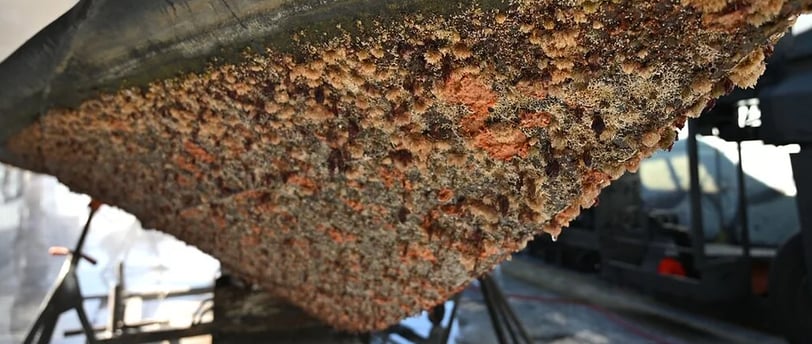Marine Fouling in South Florida
Discussion of the different sources of marine fouling in South Florida and methods for combatting it.
FOULING
12/10/20243 min read


Marine fouling is a significant concern for boat owners in South Florida, where warm waters and rich marine ecosystems create ideal conditions for various organisms to thrive on vessel hulls. This blog post will explore the different types of marine fouling that impact boats in the region and their effects on vessel performance and maintenance.
Common Marine Fouling Organisms in South Florida
Barnacles
Barnacles are perhaps the most notorious of all marine fouling organisms. These small crustaceans attach themselves firmly to boat hulls using a cement-like substance, forming hard, shell-like structures. In South Florida's waters, barnacles can quickly multiply, covering large areas of a boat's hull. This accumulation significantly increases drag, which in turn:
Reduces boat speed
Decreases fuel efficiency
Affects vessel maneuverability
Potentially impacts stability due to added weight
Algae
Algae is another prevalent fouling organism in South Florida's nutrient-rich waters. While it may seem less problematic than hard-shelled creatures, algae can cause significant issues.
Accelerates corrosion of the hull
Creates a slippery surface, making maintenance more hazardous
Provides a foundation for other fouling organisms to attach
Algae growth can be particularly rapid in the warm, sunny conditions typical of South Florida, making regular cleaning essential for boat owners.
Tunicates (Sea Squirts)
Tunicates, also known as sea squirts, form slimy colonies on boat hulls. In South Florida, these gelatinous organisms can be particularly troublesome:
Obstruct water intakes, potentially causing engine overheating
Form dense clusters that increase drag
Thrive in coastal waters, especially around docks and marinas
Their rapid growth and ability to filter feed make tunicates a persistent problem for boat owners in the region.
Tube Worms
Tube worms, or serpulids, are calcareous marine worms that secrete hard tubes around their bodies. In South Florida's waters, they can cause several issues:
Form dense colonies covering large areas of the hull
Increase drag, reducing speed and fuel efficiency
Potentially cause physical damage to the hull surface
Contribute to corrosion over time
Sponges
While sponges play an important role in marine ecosystems, they can be problematic for boats in South Florida. Sponges attached to boat bottoms can lead to:
Hull erosion
Increased drag
Reduced vessel performance
Sponges thrive in nutrient-rich waters, making them a common sight on boats in Florida's coastal areas.
Impact on Boats and Performance
The cumulative effect of these marine fouling organisms on boats in South Florida can be substantial. The warm, salty waters of the Gulf Coast are particularly corrosive and conducive to rapid growth of fouling species. This environment can lead to:
Increased fuel consumption due to added drag
Reduced top speed and overall performance
More frequent and costly maintenance
Potential damage to the hull and underwater components
Decreased resale value of the vessel
Biosecurity Concerns
Beyond the immediate impact on boat performance, marine fouling in South Florida also poses biosecurity risks. Recreational boats can inadvertently transport invasive species to new areas. For instance:
Five invasive marine species were known in a study area, with evidence suggesting their presence on boat hulls
Boats on swing moorings, which are common in Florida, may be at higher risk of transporting invasive species due to their typically lower speeds and less frequent cleaning
Prevention and Management
To combat marine fouling in South Florida's challenging environment, boat owners should consider several strategies:
Antifouling Paint
Choosing the right bottom paint is crucial for boats in Florida waters. Antifouling paints work by:
Discouraging the attachment of marine organisms
Slowly releasing biocides to prevent fouling growth
Providing a smooth surface that makes it difficult for organisms to adhere
Regular Cleaning and Maintenance
Consistent hull cleaning is essential in South Florida's fouling-prone waters:
Regular scrubbing to remove soft fouling like algae and slime
Professional cleaning services, such as wet abrasive blasting, for more stubborn organisms like barnacles and tube worms
Inspection of underwater components for signs of fouling or damage
Proper Mooring and Storage
How and where a boat is kept can significantly impact fouling:
Boats on swing moorings tend to accumulate more fouling than those in berths
Consider using marina berths or dry storage when possible
Ensure proper water flow around the hull to discourage stagnant conditions that promote fouling
Advanced Antifouling Technologies
New technologies are emerging to combat marine fouling in challenging environments like South Florida:
Ultrasonic antifouling systems that use sound waves to repel fouling organisms
These systems can provide continuous protection and may reduce the need for toxic antifouling paints
Conclusion
Marine fouling is a persistent challenge for boat owners in South Florida, with various organisms from barnacles to sponges posing threats to vessel performance and integrity. The warm, nutrient-rich waters of the region create an ideal environment for rapid fouling growth, necessitating vigilant maintenance and effective prevention strategies. By understanding the types of fouling organisms present and implementing a comprehensive approach to hull protection, boat owners can maintain their vessels' performance, reduce maintenance costs, and minimize environmental impact. Regular cleaning, appropriate antifouling measures, and consideration of new technologies will help ensure that boats remain in top condition despite the challenging marine environment of South Florida.


